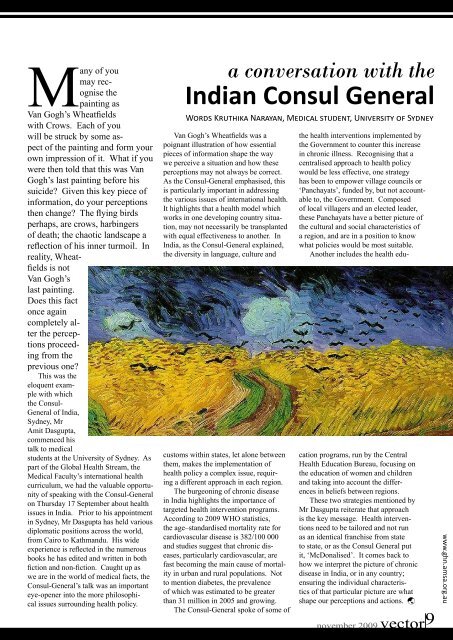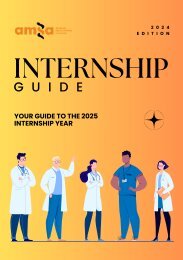Create successful ePaper yourself
Turn your PDF publications into a flip-book with our unique Google optimized e-Paper software.
Many of you<br />
may recognise<br />
the<br />
painting as<br />
Van Gogh’s Wheatfields<br />
with Crows. Each of you<br />
will be struck by some aspect<br />
of the painting and form your<br />
own impression of it. What if you<br />
were then told that this was Van<br />
Gogh’s last painting before his<br />
suicide? Given this key piece of<br />
information, do your perceptions<br />
then change? The flying birds<br />
perhaps, are crows, harbingers<br />
of death; the chaotic landscape a<br />
reflection of his inner turmoil. In<br />
reality, Wheatfields<br />
is not<br />
Van Gogh’s<br />
last painting.<br />
Does this fact<br />
once again<br />
completely alter<br />
the perceptions<br />
proceeding<br />
from the<br />
previous one?<br />
This was the<br />
eloquent example<br />
with which<br />
the Consul-<br />
General of India,<br />
Sydney, Mr<br />
Amit Dasgupta,<br />
commenced his<br />
talk to medical<br />
students at the University of Sydney. As<br />
part of the Global Health Stream, the<br />
Medical Faculty’s international health<br />
curriculum, we had the valuable opportunity<br />
of speaking with the Consul-General<br />
on Thursday 17 September about health<br />
issues in India. Prior to his appointment<br />
in Sydney, Mr Dasgupta has held various<br />
diplomatic positions across the world,<br />
from Cairo to Kathmandu. His wide<br />
experience is reflected in the numerous<br />
books he has edited and written in both<br />
fiction and non-fiction. Caught up as<br />
we are in the world of medical facts, the<br />
Consul-General’s talk was an important<br />
eye-opener into the more philosophical<br />
issues surrounding health policy.<br />
a conversation with the<br />
Indian Consul General<br />
Words Kruthika Narayan, Medical student, University of Sydney<br />
Van Gogh’s Wheatfields was a<br />
poignant illustration of how essential<br />
pieces of information shape the way<br />
we perceive a situation and how these<br />
perceptions may not always be correct.<br />
As the Consul-General emphasised, this<br />
is particularly important in addressing<br />
the various issues of international health.<br />
It highlights that a health model which<br />
works in one developing country situation,<br />
may not necessarily be transplanted<br />
with equal effectiveness to another. In<br />
India, as the Consul-General explained,<br />
the diversity in language, culture and<br />
customs within states, let alone between<br />
them, makes the implementation of<br />
health policy a complex issue, requiring<br />
a different approach in each region.<br />
The burgeoning of chronic disease<br />
in India highlights the importance of<br />
targeted health intervention programs.<br />
According to <strong>2009</strong> WHO statistics,<br />
the age–standardised mortality rate for<br />
cardiovascular disease is 382/<strong>10</strong>0 000<br />
and studies suggest that chronic diseases,<br />
particularly cardiovascular, are<br />
fast becoming the main cause of mortality<br />
in urban and rural populations. Not<br />
to mention diabetes, the prevalence<br />
of which was estimated to be greater<br />
than 31 million in 2005 and growing.<br />
The Consul-General spoke of some of<br />
the health interventions implemented by<br />
the Government to counter this increase<br />
in chronic illness. Recognising that a<br />
centralised approach to health policy<br />
would be less effective, one strategy<br />
has been to empower village councils or<br />
‘Panchayats’, funded by, but not accountable<br />
to, the Government. Composed<br />
of local villagers and an elected leader,<br />
these Panchayats have a better picture of<br />
the cultural and social characteristics of<br />
a region, and are in a position to know<br />
what policies would be most suitable.<br />
Another includes the health education<br />
programs, run by the Central<br />
Health Education Bureau, focusing on<br />
the education of women and children<br />
and taking into account the differences<br />
in beliefs between regions.<br />
These two strategies mentioned by<br />
Mr Dasgupta reiterate that approach<br />
is the key message. Health interventions<br />
need to be tailored and not run<br />
as an identical franchise from state<br />
to state, or as the Consul General put<br />
it, ‘McDonalised’. It comes back to<br />
how we interpret the picture of chronic<br />
disease in India, or in any country;<br />
ensuring the individual characteristics<br />
of that particular picture are what<br />
shape our perceptions and actions. <br />
november <strong>2009</strong> vector9<br />
www.ghn.amsa.org.au
















